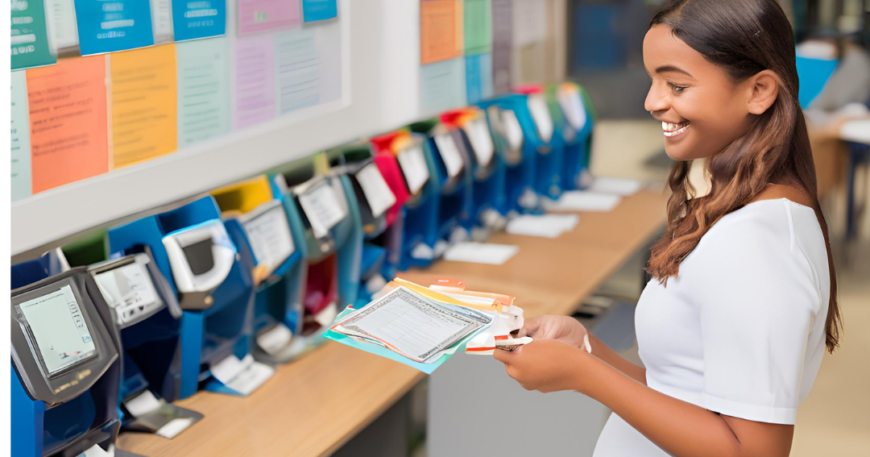Introduction
Managing attendance in schools has always been a tedious task. Manual roll calls and paper registers are prone to errors, time-consuming, and often outdated. This is where automated attendance systems come into play. These systems not only streamline the process but also ensure accuracy and efficiency, making them indispensable in modern educational settings.
What is an Automated Attendance System?
An automated attendance system is a technology solution that records and manages student attendance digitally. These systems can track attendance using various methods such as RFID, biometrics, mobile apps, and facial recognition. Key features often include real-time data capture, integration with other school management systems, and automated reporting.
Types of Automated Attendance Systems
- RFID-Based Systems: Use radio-frequency identification tags to track students.
- Biometric Systems: Utilize fingerprints or other biometric data for identification.
- Mobile App-Based Systems: Allow attendance tracking via smartphones.
- Facial Recognition Systems: Employ cameras and software to recognize student faces.
Benefits of Automated Attendance Systems
Improved Accuracy and Efficiency
Automated systems minimize human errors associated with manual attendance. They ensure that attendance data is accurate and promptly recorded, reducing discrepancies and ensuring data integrity.
Real-Time Data and Reporting
These systems provide real-time attendance data, which can be accessed by teachers, administrators, and even parents. This immediate availability of information helps in quickly identifying attendance issues and trends.
Reduction in Administrative Work
By automating the attendance process, schools can significantly reduce the administrative workload. Teachers and staff no longer need to spend time manually recording and compiling attendance data, allowing them to focus more on educational activities.
Enhanced Student Accountability
Automated systems promote accountability among students by making attendance tracking more transparent and tamper-proof. This can lead to improved attendance rates and better student engagement.
Key Features to Look for in an Automated Attendance System
Integration with Existing Systems
Ensure that the attendance system can seamlessly integrate with your school’s existing software and infrastructure. This facilitates a smooth data flow and enhances overall efficiency.
User-Friendly Interface
A user-friendly interface is crucial for easy adoption and usage by both staff and students. The system should be intuitive and straightforward to operate.
Security and Privacy Considerations
Given the sensitive nature of attendance data, robust security measures are essential. Look for systems that offer encryption, secure data storage, and compliance with relevant data protection regulations.
Customizable Alerts and Notifications
Automated alerts and notifications can be highly beneficial. For instance, the system can notify parents if their child is absent or inform administrators about unusual attendance patterns.
Top Automated Attendance Systems for Schools
RFID-Based Attendance Systems
Overview: RFID systems use tags that emit radio signals. When a student with an RFID tag passes by a reader, their attendance is automatically recorded.
Pros:
- Fast and non-intrusive.
- Can handle large volumes of data.
Cons:
- Requires physical tags which can be lost or damaged.
- Limited to locations with RFID readers.
Biometric Attendance Systems
Overview: These systems use biometric data such as fingerprints or iris scans to identify students.
Pros:
- Highly accurate and difficult to forge.
- Eliminates the need for physical tokens.
Cons:
- Privacy concerns over biometric data.
- Can be costly to implement.
Mobile App-Based Attendance Systems
Overview: Students use their smartphones to check in via a dedicated app.
Pros:
- Convenient and accessible.
- Can be used remotely.
Cons:
- Requires students to have smartphones.
- Dependent on internet connectivity.
Facial Recognition Systems
Overview: These systems use cameras and software to automatically recognize and record student attendance based on their faces.
Pros:
- Hands-free and unobtrusive.
- Can be integrated with security systems.
Cons:
- Privacy and ethical concerns.
- Requires high-quality cameras and software.
RFID-Based Attendance Systems
RFID technology involves tags and readers. Each student carries an RFID tag, usually in the form of an ID card, which emits a signal to an RFID reader. This technology is effective for tracking attendance in specific locations like entry gates or classrooms.
Examples of RFID-Based Systems
- SchooTrack: Integrates with school management systems and provides real-time attendance data.
- TrackMySchool: Offers detailed reporting and notification features.
Case Studies
Many schools have successfully implemented RFID systems to streamline attendance and reduce manual errors. For instance, a high school in California reported a 30% reduction in tardiness after adopting RFID-based attendance.
Biometric Attendance Systems
Biometric systems use unique physical characteristics for identification. Fingerprint scanners are the most common, but some systems also use retina scans or voice recognition.
Examples of Biometric Systems
- BioTrack: Known for its high accuracy and integration capabilities.
- TimeWatch: Offers comprehensive biometric attendance solutions with robust security features.
Implementation Challenges
While biometric systems are highly accurate, they can be expensive and raise privacy concerns among parents and students. Ensuring data protection and gaining community acceptance are crucial steps in successful implementation.
Mobile App-Based Attendance Systems
Mobile app-based systems allow students to check in using their smartphones. These systems are particularly useful for schools with tech-savvy students and staff.
Features of Mobile App-Based Systems
- GPS-based check-ins.
- Integration with school calendars and notifications.
- Parental access to attendance records.
Examples of Mobile Apps for Attendance
- Class123: An easy-to-use app with GPS tracking and real-time updates.
- MyAttendanceTracker: Offers customizable alerts and detailed reports.
Connectivity and Usability Considerations
Dependence on internet connectivity can be a drawback. Schools need to ensure that students have access to reliable internet and compatible devices.
Facial Recognition Systems
Facial recognition systems use cameras to capture and analyze students’ facial features. This technology is becoming increasingly popular due to its convenience and non-intrusive nature.
Advantages of Facial Recognition
- Eliminates the need for physical tokens or devices.
- Can be integrated with school security systems for enhanced safety.
Examples of Facial Recognition Systems
- FacePRO: Offers high accuracy and integration with existing security infrastructure.
- Centrak: Known for its reliability and ease of use in educational settings.
Privacy and Ethical Considerations
While facial recognition offers convenience, it raises significant privacy concerns. Schools must ensure compliance with data protection laws and address ethical issues regarding surveillance.
Choosing the Right Attendance System for Your School
Assessing School Needs
Evaluate the specific needs of your school, such as the size of the student body, existing infrastructure, and budget constraints. Understanding these factors will help you choose the most suitable system.
Budget Considerations
Automated attendance systems vary widely in cost. Consider both the initial setup expenses and ongoing maintenance costs when making your decision.
Implementation and Training
Ensure that staff and students are adequately trained to use the new system. Effective implementation involves not only installing the technology but also integrating it into daily routines and procedures.
Case Studies
Successful Implementations in Schools
A middle school in Texas implemented a biometric system and saw a significant improvement in attendance tracking accuracy. Another school in New York adopted a mobile app-based system, which resulted in higher student participation and engagement.
Lessons Learned
Schools that successfully implemented these systems emphasized the importance of stakeholder buy-in and thorough training. Addressing concerns early and providing continuous support were key factors in their success.
Future Trends in Automated Attendance Systems
AI and Machine Learning Integration
Future systems may leverage AI to predict attendance patterns and identify potential issues before they arise. Machine learning can enhance accuracy and adapt to changing school environments.
Enhanced Data Analytics
Advanced analytics can provide deeper insights into attendance trends and student behavior, helping schools make informed decisions.
Cloud-Based Solutions
Cloud-based systems offer scalability and flexibility, making them ideal for schools with varying needs and resources.
Challenges in Implementing Automated Attendance Systems
Technical Challenges
Integrating new systems with existing infrastructure can be complex. Schools need to address compatibility issues and ensure seamless operation.
Resistance to Change
Introducing new technology can be met with resistance from staff or students. Effective communication and training can help mitigate these challenges.
Cost Implications
While automated systems offer long-term benefits, the initial investment can be significant. Schools must carefully consider their budget and explore funding options if needed.
Conclusion
Automated attendance systems are transforming the way schools manage attendance. By choosing the right system, schools can enhance accuracy, reduce administrative work, and improve student accountability. The key is to assess your school’s specific needs, consider budget constraints, and ensure proper implementation and training. As technology continues to evolve, these systems will become even more integral to modern education.
FAQs
- What are the common problems with traditional attendance systems?
- Traditional systems are prone to errors, time-consuming, and often lack real-time data capabilities, making them less efficient.
- How do automated attendance systems improve student safety?
- They provide real-time attendance data and can send alerts for absences, helping schools and parents monitor student safety more effectively.
- Can automated attendance systems integrate with school management software?
- Yes, most modern systems are designed to integrate seamlessly with existing school management software for enhanced functionality.
- What are the privacy concerns with biometric and facial recognition systems?
- These systems can raise concerns about data security and misuse. It’s essential to implement strong data protection measures and obtain consent from parents and students.
- How can schools handle resistance from staff or students regarding new attendance systems?
- Effective communication, training, and involving stakeholders in the decision-making process can help address resistance and facilitate smooth adoption.





